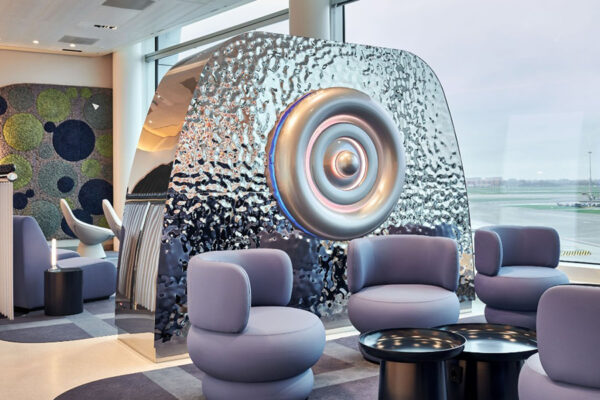The virtual realm continues to influence physical designs with a digital cozy aesthetic. We round up the latest directions to explore.
Note: This is an excerpt from WGSN’s “Key Trends: Digital Cosy” report by Joanna Thornhill, published March 28, 2024.
Executive Summary
Opportunity
The gaps are shortening, design-wise, between the real-world and the virtual world as tech simplifies processes and techniques otherwise hard to achieve, and fantasy online realms become more softened and human, bringing heightened elements of coziness and relatability from IRL, and vice-versa.
Technology and digitally-inspired aesthetics are influencing physical designs, creating boundary-blurring looks. A.I. image generation platform Midjourney has grown a base of 16m users in just over two years since its launch and hit $300m revenue in February 2024, sharing that while 68% of its users are on it “predominantly for fun,” 32% use it for “utility,” highlighting it (and similar other tools) as key for practical industry applications. On a more approachable level, the 3D printing industry is expected to register a global CAGR of 21% between 2021-26, as the flexibility it offers in terms of manufacturing on-demand and more responsible material usage are reaching mainstream.
Need to know:
- Integrating inviting and reassuring aspects to digitally created or digital-looking physical pieces offers a key way to assuage A.I.-anxious consumers, as well as anxious consumers who are drawn to safety and coziness amid a continuing polycrisis
- Ikea’s Life at Home 2023 report cites comfort as one of eight core needs for a better life at home, yet 27% of those surveyed stated they find this important but only sometimes, rarely or never have it fulfilled at home
- Apartment Therapy’s State of Home Design for 2024 flags “cozy” as one of the key words that will be pivotal to describing home design in 2024
Almost Unreal
The Concept: AI-prompted digital dreamscape worlds are growing: the hashtag #AIarchitecture appears on almost 207k posts on Instagram, led by the work of AI artists who blend exaggerated aesthetics with organic softness and curves. This is influencing real-world products and spaces, with images that appear at first to be completely artificial, but are not.
Materials and Manufacturing: look to #tintedtransparency and ethereal, reflective materials alongside playful 3D printing techniques to achieve digitized looks using shapes and surface texture to bring a sense of softness. Play with textiles and cushioning, exaggerating both aspects to create designs that border on cartoonification.
Design and styling: experiment with using conceptual backdrops to bring a digital aesthetic to product designs in showrooms, exhibitions or marketing photography. This can apply to both intriguing set design and artful installations, or a more literal blending of the real world and digital realms.
Play with placing product photographs onto fantastical CGI backgrounds, or use interactive surface projections to bring a surreal element to real-life spaces.
Blurred Reality
The Concept: while some designers fear the move towards “design generated by algorithms and, thus, toward a drastic depletion of what makes humans unique” (Maison&Objet Nov23 Barometer report), many are still actively turning to A.I. and other digital software as a creative collaborator.
Design Approach: look for ways to blend the best of algorithmic, generative design with the hands-on talent of experienced makers and artisans for forward-focused outcomes that retain a human touch. #3Dprinting offers an approachable way to implement this: the Hourglass lamp by Streicher Goods (USA) features a hand-thrown clay base seamlessly blended with a 3D-printed shade.
Parisian studio TRAME takes a more integrative approach, using craft to transform a generative artist’s code (and design outcomes) into tangible, handmade pieces created using traditional mediums such as tapestry and stained glass.
Growth Area: treat A.I. as an ally, a tool and a creative partner to help you reimagine conventional designs. Investigate how traditional crafting materials such as clay can be used within statement 3D printing to create pieces which still hold a familiarity despite being produced via an extruder rather than directly by hand.
Immersive Sanctuary
The Concept: soothing, enveloping spaces that connect to nature and encompass ancient cave-like aesthetics push the design boundaries with digital-influenced shapes, finishes and tinted color graduations.
Darker-toned, color-clad cocooning spaces create an immersive feel: Apartment Therapy’s State of Home Design report for 2024 highlights an aesthetic shift into “darker, moodier territories” alongside more digital-look tones that play with opacity, ombré effects and optical illusions.
Design Approaches: look to designs that mimic natural silhouettes such as waves or mountains to enhance a feeling of cozy connection to nature. Consider the sensorial journey for customers, clients or consumers navigating around your space while playing with futuristic lighting effects, such as strategically arranged fluorescent tube lights, paying attention to touchpoints or wayfinding for a sense of welcome and respite.
Materials and Surfaces: introduce tactile, raw or softly rough textures and natural surfaces to create stylized or digital-looking shapes, achieving a sense of biophilia. Look at ways of visually softening typically hard or straight-edged products like shower screens or entrances through rounded doors or openings.















